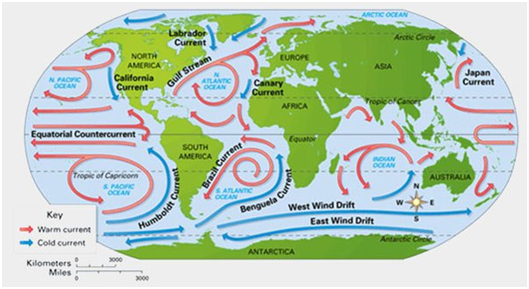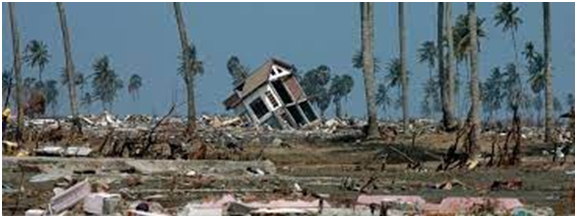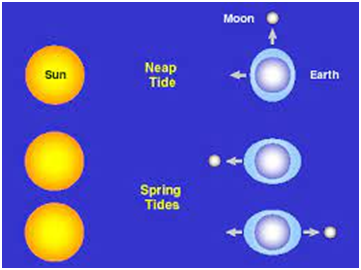- Books Name
- Social Science Book
- Publication
- Cognizance Publication
- Course
- CBSE Class 7
- Subject
- Social Science
Ocean current
The streams of water flowing constantly on the ocean surface indefinite direction. A current is like a huge river within an ocean,flowing from one place to another.

Ocean currents are of two type:
Warm ocean currents: These ocean currents originate nearby equator and move towards the poles. Example Gulf Stream.
Cold ocean currents: These ocean currents carry water from polar or higher latitude to tropical or lower latitudes. Example the Labrador Ocean current.
Importance of ocean currents
Ocean currents influence the temperature conditions of the area. Warm currents bring about warm temperature over land surface.The areas where the warm and cold currents meet provide the best fishing grounds of the world.Seas around Japan and the eastern coast of North America are such examples. The areas were a warm and cold current meet also experience foggy weather, making it difficult for navigation.
Tsunami
An earthquake, a volcanic eruption or underwater landslides can shift large amount of ocean water. As a result, a huge tidal wave called Tsunami. As high as 15 metre is found.Travel at the speed of more than 700 km per hour.Tsunami of 2004 causes wide spread damage in the coastal areas of India.
The Indira point in Andaman and Nicobar Islands got submerged after the tsunami. Tsunami is the Japanese word that means harbour waves as the harbour get destroyed whenever there is tsunami.

Tsunami wave struck havoc in Indian Ocean on the 26th December 2004. The wave was the result of earthquake that has its epicenter close to the western boundary of Sumatra. The magnitude of earthquake was 9.0 on the Richter scale.As the Indian plate went under the Burma plate, there was a sudden movement of the sea floor causing the earthquake. The ocean floor was displaced by about 10-20m and tilted in a downwardly direction. A huge mass of ocean water flowed to fill in the gap that was being created by the displacement. This marked the withdrawal of water mass from the coastlines of the landmasses in the South and Southeast Asia.After thrusting of the Indian plate below the Burma plate the watermass rushed back towards the coastline.Tsunami travelled at a speed of about 800 km per hour, comparable to the speed of commercial aircraft and completely washed away some of the islands in India also.
The Indira point in Andaman and Nicobar Island that mark the southernmost point of India got completely submerged.As the wave move from earthquake epicenter from Sumatra towards Andaman Island, the wavelength decreases with decrease in depth of water.Tsunami waves travelled up to a depth of 3 km from the coast, killing more than 10,000 people, and affected more than lack of houses in India. The worst affected were the coastal areas of Andhra Pradesh, Tamil Nadu, Kerala, Puducherry,Andaman and Nicobar islands.The earthquake cannot be predicted in advance, but it is possible to give a three hour notice of potential tsunami.Such early warning systems are in place across the Pacific Ocean but not in Indian Ocean.Tsunami’sare rare in Indian Ocean as the seismic activity is less as compared to the Pacific.The tsunami that ravaged the South and Southeast Asian coast in December 2004 is the most devastating tsunami in the last several 100 years. The large damage caused to life and property was primarily a result of lack of monitoring, early warning system and knowledge among the coast dwellers of Indian Ocean.
Tides
The rhythmic rise and fall of ocean water twice in a day is called a tide. It is high tide when water covers much of the shore by rising to its highest level, it is low tide when waterfalls to its lowest level and recedes from the shore.
Causes of tide

Strong gravitational pull exerted by the sun and the moon on the earth surface causes the tides.The water of the Earth closer to the moon gets pulled under the influence of the moons gravitational force and causes high tide.
Spring tide- During the full moon and new moon days,the sun, the moon and earth are in the same line and the tides are highest. These tides are called Spring Tides.
Neap Tides-When the moon is in its first and last quarter, the ocean water gets drawn in diagonally opposite directions by the gravitational pull of sun and earth, resulting in low tides. These tides are called neap tides.
Importance of Tides:
High tides help in navigation.They raise the water level close to the shores which helps the ships to arrive at the harbour more easily. The high tides also help in fishing as many more fish come closer to the shore during the high tide.This enables fishermen to get a plentiful catch.The rise and fall of water due to tides is being used to generate electricity in some places.

 Cognizance Publication
Cognizance Publication
